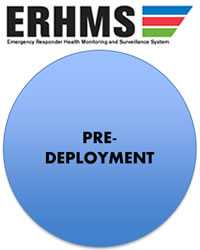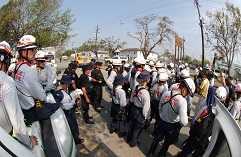EMERGENCY RESPONDER HEALTH MONITORING AND SURVEILLANCE (ERHMS)™

Pre-Deployment Phase
Rostering and Credentialing of Emergency Response and Recovery Workers

A basic principal of safety and health in emergency response is to maintain accountability for all emergency responders. The registration and credentialing system for emergency response and recovery workers should support four functions designed to operate with one another:
- Registration – Recording basic and credential information on the worker.
- Emergency credentialing – Assigning a credential level based on responder certification and education.
- Re-verification – Periodically confirming responder information.
- Emergency badging – Assigning an identification badge in accordance with the credential level.
Since the information requirements of each function are interdependent, these four functions should be integrated within a single database.
Tools & Resources
- DHHS Emergency System for Advance Registration of Volunteer Health Professionals (video)
- ERHMS Basic Rostering and Credentialing Example
- ERHMS Fact Sheet: Rostering and Credentialing of Emergency Response and Recovery Workers
- NIOSH – Guidance for Protecting Emergency Responders
Pre-deployment Health Screening for Emergency Responders

Within the framework of an ERHMS program, pre-deployment health screening is intended to establish a baseline physical and emotional health status. Such information may be found from an entrance physical examination to determine fitness for duty, or from subsequent fitness-for-duty examinations. This baseline information allows for more informed interpretation of possible post-deployment adverse effects and is potentially valuable when exposure information is difficult to obtain or interpret, or is absent. Baseline health assessment should address the responder’s physical health, emotional health, and immunization status. In addition to providing baseline health information, the pre-deployment screening can serve as an opportunity to assess whether the response has persons with the appropriate education, training, and experience to perform in the assigned response capacities.
Tools & Resources
- American Red Cross Pre-Assignment Health Questionnaire
- CDC Epidemiology and Prevention of Vaccine-Preventable Diseases, the Pink Book
- CDC Frequently Asked Questions About Small Pox Vaccine
- CDC Immunization Recommendations for Disaster Responders
- CDC Interim Guidance for Pre-Exposure Medical Screening of Workers Deployed for Hurricane Disaster Work
- CDC Medical Pre-Placement Evaluation for Workers Engaged in the Deepwater Horizon Response
- CDC Morbidity and Mortality Weekly Report – Interventions to Prevent Infection with Hepatitis B Virus, Hepatitis C Virus, or Human Immunodeficiency Virus, and Tetanus in Persons Wounded During Bombings and Similar Mass-Casualty Events
- CDC Vaccine Recommendations of the Advisory Committee for Immunization Practices (ACIP)
- Center for Domestic Preparedness Medical Screening Form
- DHCC Pre-Deployment Health Assessment Form
- ERHMS Comprehensive Pre-Deployment Evaluation Principles
- ERHMS Fact Sheet: Pre-Deployment Health Screening for Emergency Responders
- ERHMS Emergency Responder Health Monitoring and Surveillance: Implementation Training Worksheet
- ERHMS Enhanced Pre-Deployment Evaluation
- ERHMS Pre-deployment Health Screening for Emergency Responders
- Flight Crew Medical Screening
- NFPA Catalog 1582: Standard on Comprehensive Occupational Medical Program for Fire Departments, 2007 Edition
- NFPA Codes and Standards 1582 Chapter 6 Medical Evaluations of Candidates
- OSHA Personal Protective Equipment – Respirator Medical Evaluation Questionnaire
- USCG Directives, Commandant Instruction Manuals – Medical Manual CIM 6000.1C
Health and Safety Training

Training is critical for the preparedness of the responder. The responder is required to be fully prepared to perform duty-specific tasks, which may have federal, state, or locally mandated training requirements. The ability of the responder to recognize and avoid possible health and safety incidents will affect the responder’s performance, survivability, and resilience during and after the disaster response. Regardless of the training a responder has received prior to a disaster, there will be a need for training focused on site-specific hazards, operating procedures, and available resources.
Ongoing analysis of ERHMS data during the response must identify training needs and changes in procedures that could reduce injuries, illnesses, and near misses. Additionally, the ERHMS program can provide valuable post-disaster data to evaluate the impact of responder training, including site-specific training on overall injury and illness rates for responders and specific illnesses and injuries.
Tools & Resources
- CDC Emergency Preparedness and Response – Training and Education
- Citizen Corps – Uniting Communities and Preparing the Nation
- ERHMS Fact Sheet: Health and Safety Training
- FEMA Center for Domestic Preparedness
- FEMA National Preparedness Directorate – National Training and Education
- FEMA National Training Program
- NIH National Clearinghouse for Worker Safety and Health Training
- NIH HAZMAT and Safety Training
- NIOSH Deep Water Horizon Response Incident Specific Training
- OSHA Emergency Preparedness and Response
- OSHA Safety and Health TopicsDepartment of Labor
- Pipeline and Hazardous Materials Safety Administration (PHMSA) Preparedness and Response
Data Management and Information Security

Computer databases provide an excellent format for management of emergency responders’ information throughout all phases of disaster preparedness and response. However, this information includes private and personally identifiable information that may be collected and reported in a variety of formats. In order to maintain privacy required by law and to facilitate efficient communication between responding agencies, stored information must be secure and computer systems must be compatible. As agencies begin ERHMS-related activities for their employees, addressing these issues in the pre-deployment phase will ensure accurate management of responders during deployment and enable reliable, comprehensive monitoring and surveillance post-deployment.
There are six steps recommended for developing an effective pre-deployment information system security plan for use in the field:
Step 1 – Form an information security structure. This can be one individual, such as the Information Security Officer, whose responsibility is to lead the development and implementation of all information security policies and procedures.
Step 2 – Perform a baseline assessment of security needs. Identify and evaluate any pre-existing internal policies and procedures, mutual contracts or obligations, and all security-related assets.
Step 3 – Identify relevant laws, regulations, and statutes applicable to the agency and information collected.
Step 4 – Develop a work plan. Outline the necessary steps and responsibilities based on the baseline assessment and the applicable regulations.
Step 5 – Acquire and implement necessary security procedures.
Step 6 – Begin to manage risk through incremental changes.
These steps can significantly improve information confidentiality, integrity, and availability.
Tools & Resources
- Page last reviewed: July 10, 2014
- Page last updated: October 3, 2017
- Content source:
- National Institute for Occupational Safety and Health Office of the Director


 ShareCompartir
ShareCompartir